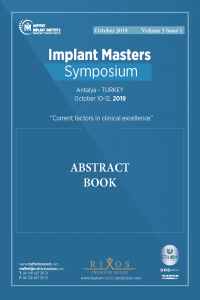Evaluation of Posterior Superior Alveolar Artery with Relation to Sinus Augmentation Procedure: A New Approach
Öz
Introduction: Sinus floor augmentation is a relative safe procedure, but severe haemorrhage may occur as a result of arterial injury. Knowledge of the blood supply of the maxillary sinus is mandatory to avoid complications. Previous studies about posterior superior alveolar artery (PSAA) localization were evaluated the crest-to-bony canal distance. However, in the case of long-term edentulousness or chronic periodontitis, there are different levels of resorption in the alveolar crest and the bone level varies from patient to patient. Materials and Methods: The aim of the study was to analyze the differences in the presence of PSAA, and distance from the inferior border of the PSAA to the newly defined plane instead of alveolar crest in the premolar and molar areas using CBCT images. A total of 270 sinus CBCT scans from 139 patients were included in this study. The presence of the PSAA according to age and sex were compared using the chi-squared test. The distance from the inferior border of the PSAA to the defined plane in the premolar and molar areas according to age and sex were tested using independent t tests. Results: The presence of PSAA did not differ significantly between males and females in all regions (P> 0.05) and did not differ significantly between subjects in all ages (P> 0.05). The distance from the inferior border of the PSAA to the defined plane in the premolar and molar areas indicated and according to age and sex did not reveal any significant differences (P> 0.05). Discussion & Conclusion: Damage of the PSAA can cause bleeding, obscuring of vision and may lead to perforation of the Schneiderian membrane, which prolongs the operation. A dental CT scan is recommended prior to surgery but if the artery is not identified, findings of this study can help for minimizing damage to PSAA. Keywords: Sinus augmentation.
Anahtar Kelimeler
Kaynakça
- .
Ayrıntılar
| Birincil Dil | İngilizce |
|---|---|
| Konular | Diş Hekimliği |
| Bölüm | Makaleler |
| Yazarlar | |
| Yayımlanma Tarihi | 13 Ekim 2019 |
| Yayımlandığı Sayı | Yıl 2019 Cilt: 3 Sayı: 1 |


